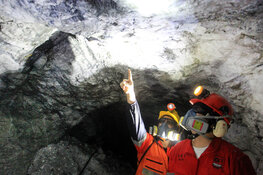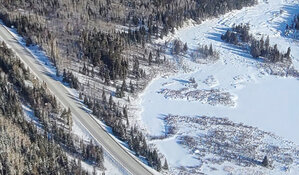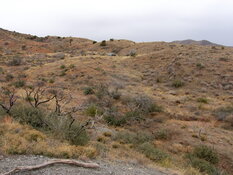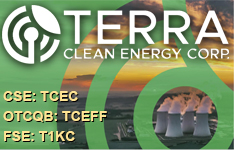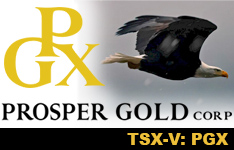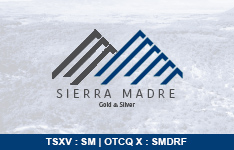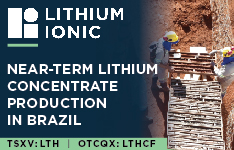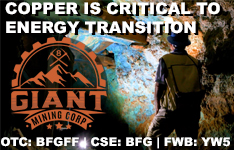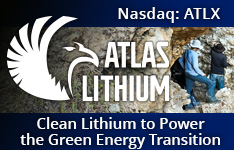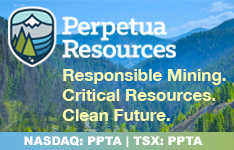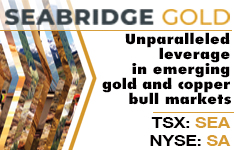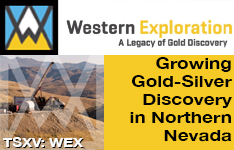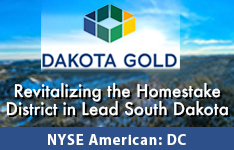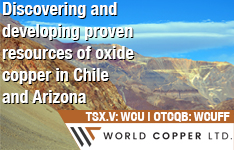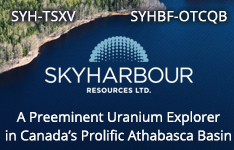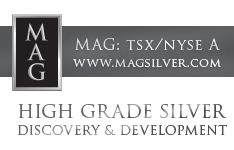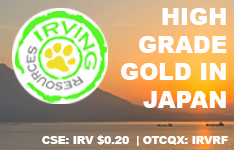Dryden Gold Corp. (DRY:TSXV; DRYGF:OTCQB) has announced the intersection of a new mineralized structure containing visible gold (VG) at its Elora target within the Gold Rock Camp in Ontario's Dryden District. The discovery was made in hole KW-25-003, which cut through a folded quartz vein in sheared basalt approximately 80 meters from the main Elora mineralized structure. This marks what the company describes as "the most significant amount of VG that Dryden Gold has intersected to date," according to President Maura Kolb in the company news release.
The newly identified zone is located within the hanging wall of the Elora Gold System, which, like the broader Gold Rock Camp, lies within a region geologically similar to the Red Lake, Kirkland Lake, and Timmins Archean lode gold camps. Drilling at Elora is part of Dryden Gold's fully funded 2025 drill program, which began in late March and is targeting depths between 250 and 550 meters. All five holes completed at depth so far have intersected zones of shearing and sulfide mineralization consistent with the project's exploration model.
Initial assays from the 2025 campaign include results from hole KW-25-001, which returned 4.00 grams per tonne (g/t) gold over 3.07 meters, including a higher-grade intercept of 18.10 g/t over 0.45 meters. Assay results for hole KW-25-002 remain pending. The company noted that its sampling protocols use NQ-size drill core, which is cut in half for analysis, with the remaining half retained for archival purposes.
Dryden Gold is continuing to evaluate additional mineralized structures at Gold Rock, which spans more than 702 square kilometers and is supported by infrastructure, including grid power and highway access.
CEO Trey Wasser said in the press release that the Elora results show "the potential for hanging wall and footwall mineralized structures to host significant gold mineralization similar to our discoveries last year on the Big Master System." Wasser added that 2025 will be a key year as the company also drills regional targets such as Mud Lake, Sherridon, and Hyndman.
The company's 2025 exploration budget is fully funded, with CA$5.8 million allocated for drilling and related activities across its properties.
What Analysts Have Reported
Gold market analysts have acknowledged Dryden Gold's exploration strategy and recent milestones as key developments supporting its long-term positioning. On February 7, Ron Wortel of Couloir Capital stated that the company's approach aligned with its geological model and district-scale ambitions. "Dryden Gold Corp. was created to explore and generate shareholder value through gold resource discovery and delineation of the Dryden Gold Camp using an Archean orogenic gold deposit model," he wrote. Wortel added that, with a "fully funded 2025 exploration program," the company was expected to generate further discoveries that could attract greater market attention and lead to higher valuations.
On the same day, Brien Lundin of Gold Newsletter added Dryden Gold to his watchlist, noting improved exploration focus at the Gold Rock project. "A key reason I added Dryden Gold Corp. to our list last week is a sense that the company had an increasingly good idea of where to look for more gold on the Gold Rock project," he wrote. He also stated that, with drilling underway at Elora, "the chances of high-grade assays from this effort are quite good," and described the stock as a buy at current levels.
In a follow-up on February 26, Lundin highlighted Dryden Gold's receipt of permits from the Ontario Ministry of Mines as a meaningful development for the 2025 campaign. "Dryden Gold Corp. announced it had received permits . . . to test the northeastern trend at Elora and the newly discovered Mud target," he wrote. "These additions will expand the company's overall drilling campaign in 2025 to up to 15,000m."
Gold Sector Strengthens as Prices Climb and Margins Expand
Gold prices surged in the first quarter of the year, drawing renewed attention to the yellow metal's role as both a safe-haven asset and a source of portfolio diversification. According to Barron's, on April 3, gold climbed 19% during the quarter, closing at US$3,122.80 per ounce. It was the metal's strongest quarterly gain since 1986. The report cited a range of contributing factors, including inflationary pressures, geopolitical tensions, and central bank buying. "Gold just finished its best quarter since the Reagan administration," wrote Elizabeth O'Brien, who noted the appeal of the metal amid broader market declines.
In the same article, financial advisors acknowledged gold's recent strength but advised caution. Rand Spero, president of Street Smart Financial, recommended holding no more than 8% of a portfolio in gold and warned investors not to "get carried away with the story." Despite the excitement, he emphasized the importance of maintaining a balanced allocation.
Kitco News reported on April 3 that inflationary risks linked to new U.S. tariffs were expected to support continued demand for gold. Analysts at TD Securities stated that "U.S. details on tariffs were more aggressive, more immediate, more broad, and seemingly more permanent than markets were expecting." They predicted the new tariff regime would drive inflation higher, potentially lifting gold demand further as a hedge against economic uncertainty. The firm also noted that "gold is surprisingly ‘overbought, but under-owned,' particularly when considering the additional scope for safe-haven demand."
In a separate note published by Stockhead on April 4, Goldman Sachs analysts observed a two-pronged margin expansion trend among gold producers. They stated that rising gold prices, coupled with moderating cost pressures, were enabling miners to outperform the commodity itself. "We expect this gold equities cycle to continue, with stocks well positioned to continue to outperform the commodity . . . supported by rising gold prices and moderating unit cost pressures," wrote analysts led by Hugo Nicolaci. The report also highlighted that labor cost inflation among producers had been relatively contained at approximately 2–3%, based on field research conducted during a recent visit to Perth.
Goldman's analysts noted that sector focus had shifted in the past 12–24 months from production volume to margin strength and free cash flow. This emphasis, they said, had contributed to the sector's 30–40% outperformance over bullion's 19% gain in the March quarter. They added that mid-tier producers now made up 60% of the ASX gold sector, up from 40% a year earlier, complicating the competitive landscape.
Exploration Strategy Expands as Dryden Gold Advances Key Gold Rock Camp Targets
Dryden Gold's April investor presentation outlines several exploration priorities and near-term catalysts across its portfolio, with a strategic emphasis on district-scale potential at the Gold Rock Camp. Within this area, the Elora and Big Master gold systems remain the company's primary focus. Current exploration aims to define deeper mineralized zones and test the strike extension of known high-grade structures.
The recent visible gold discovery at Elora's hanging wall structure introduces a new parallel zone of interest and supports the company's theory that Gold Rock hosts stacked mineralization, similar to the Red Lake district. Additional drilling is planned along a northeast-trending corridor toward the historic Laurentian Mine and Mud Lake target, with permits in hand for expanded step-out drilling.
Dryden Gold is also advancing regional targets identified through geophysics, till/soil sampling, and field mapping. At Sherridon and Hyndman, historical high-grade surface samples and drill results — some exceeding 600 g/t gold — are being followed up with modern exploration techniques. Several new geophysical anomalies have been mapped and are scheduled for drilling in 2025.
The company is supported by a group of strategic shareholders, including Centerra Gold (9.37%) and Alamos Gold (14.44%), and maintains relationships with First Nations communities in the region. Dryden Gold's land package spans over 70,000 hectares and includes more than 50 kilometers of the gold-bearing Manitou-Dinorwic deformation zone.
 Streetwise Ownership Overview*
Streetwise Ownership Overview*
Dryden Gold Corp. (DRY:TSXV; DRYGF:OTCQB)
With a combination of high-grade historical results, limited prior deep drilling, and a well-funded exploration plan, the company expects continuous news flow from drill programs and surface work throughout 2025.
Ownership and Share Structure
According to the company, management and insiders own 7.62%, with strategic entities owning 56.78% of Dryden.
Centerra Gold Inc. (CG:TSX; CADGF:OTCPK) holds 9.37% with Alamos Gold Inc. (AGI:TSX; AGI:NYSE) holding a 14.44% stake in it. Euro Pacific Asset Management LLC owns 4.58%. There are 159 million shares outstanding.
Its market cap is CA$21 million, and it trades in a 52-week range of CA$0.40 and CA$0.095.
Important Disclosures:
- Dryden Gold Corp. are billboard sponsors of Streetwise Reports and pay SWR a monthly sponsorship fee between US$4,000 and US$5,000.
- As of the date of this article, officers and/or employees of Streetwise Reports LLC (including members of their household) own Dryden Gold Corp. securities.
- James Guttman wrote this article for Streetwise Reports LLC and provides services to Streetwise Reports as an employee.
- This article does not constitute investment advice and is not a solicitation for any investment. Streetwise Reports does not render general or specific investment advice and the information on Streetwise Reports should not be considered a recommendation to buy or sell any security. Each reader is encouraged to consult with his or her personal financial adviser and perform their own comprehensive investment research. By opening this page, each reader accepts and agrees to Streetwise Reports' terms of use and full legal disclaimer. Streetwise Reports does not endorse or recommend the business, products, services or securities of any company.
For additional disclosures, please click here.



